My child won’t listen to me – 10 tips to turn things around
Hello to lots of new subscribers over the summer. It’s Simone Davies here from The Montessori Notebook and Jacaranda Tree Montessori.
I’ve been on summer break here in Amsterdam but now I’m back you’ll receive these letters every couple of weeks to help you bring Montessori into your homes.
What a summer it has been. I don’t get to visit my family and friends in Australia often. So it was an absolute treat to visit them this summer. It means switching the summer for the winter, but Sydney winters are mostly 15 degrees and sunny – I can handle that.
Now it’s Friday and I’m getting ready for my classes which start again next week. I’ve been painting the shelves and tables to freshen things up; changing activities; puzzling over the perfect tray to use; and giving everything a good clean. I’m so looking forward to seeing everyone and meeting some new faces too.
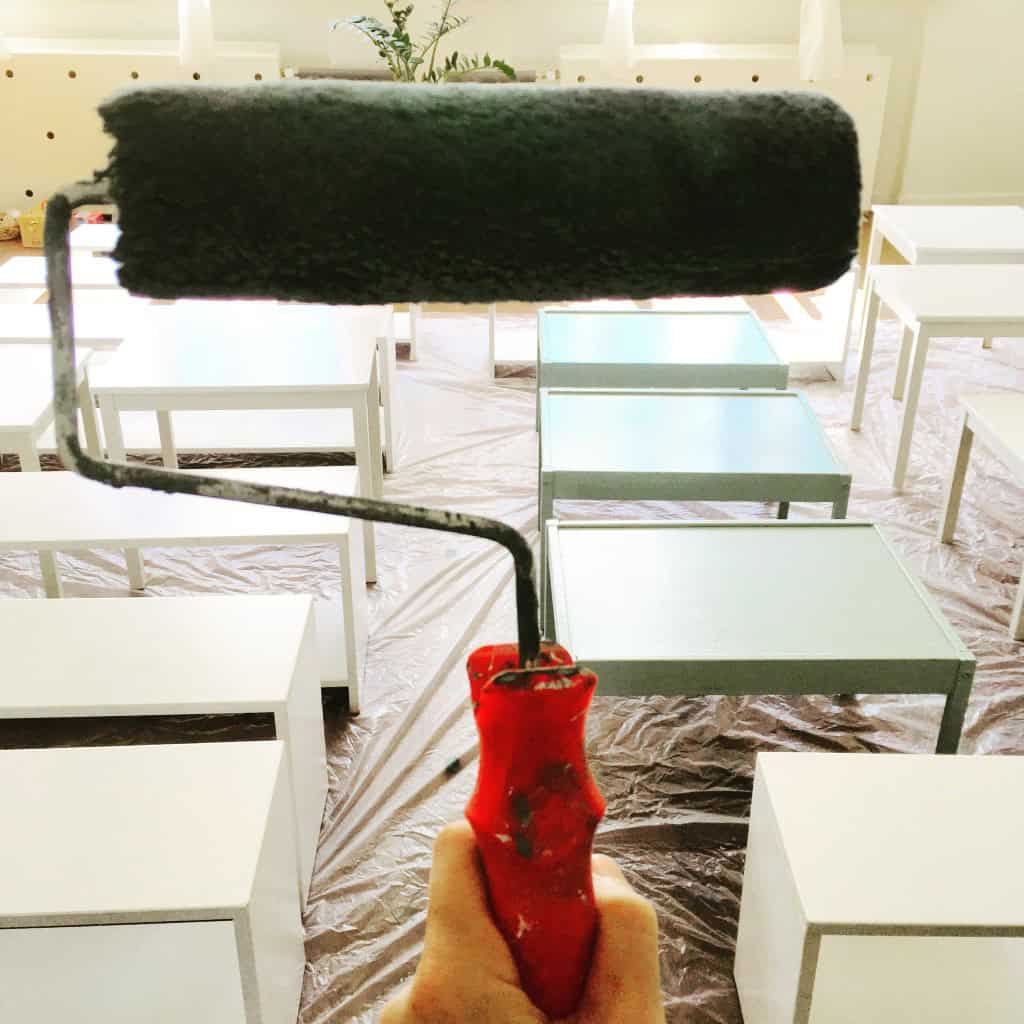
My child won’t listen to me – 10 tips to turn things around
One of the most difficult things we face as parents is when our kids just don’t seem to listen to us. Back in May, I put together 10 tips and shared them on Facebook. With summer behind us, it seems like a good time to put all these together in one place to come back to when our kids are getting tired, when we are rushing to get out the door, and when we generally just want to be reminded of other ways to connect with our children.
So here we go!
1. Show, not tell
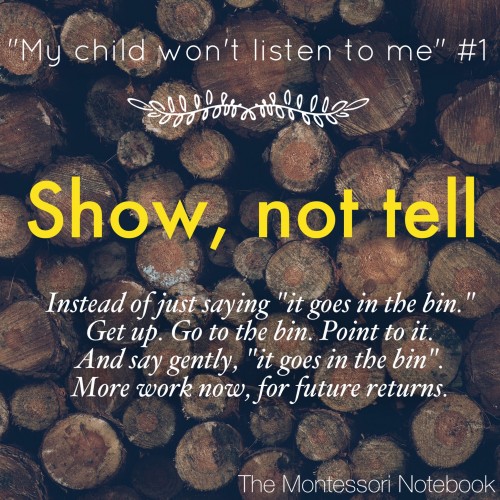
Here’s one from me that was inspired by a photography video I was watching. Their tip was to move your feet – don’t rely on your zoom lens; get up and move around to get a better photograph. I see the same with kids. Rather than just giving instructions, get up and show your child. It may take more effort initially, but your child will pick things up quickly.
2. Say one word
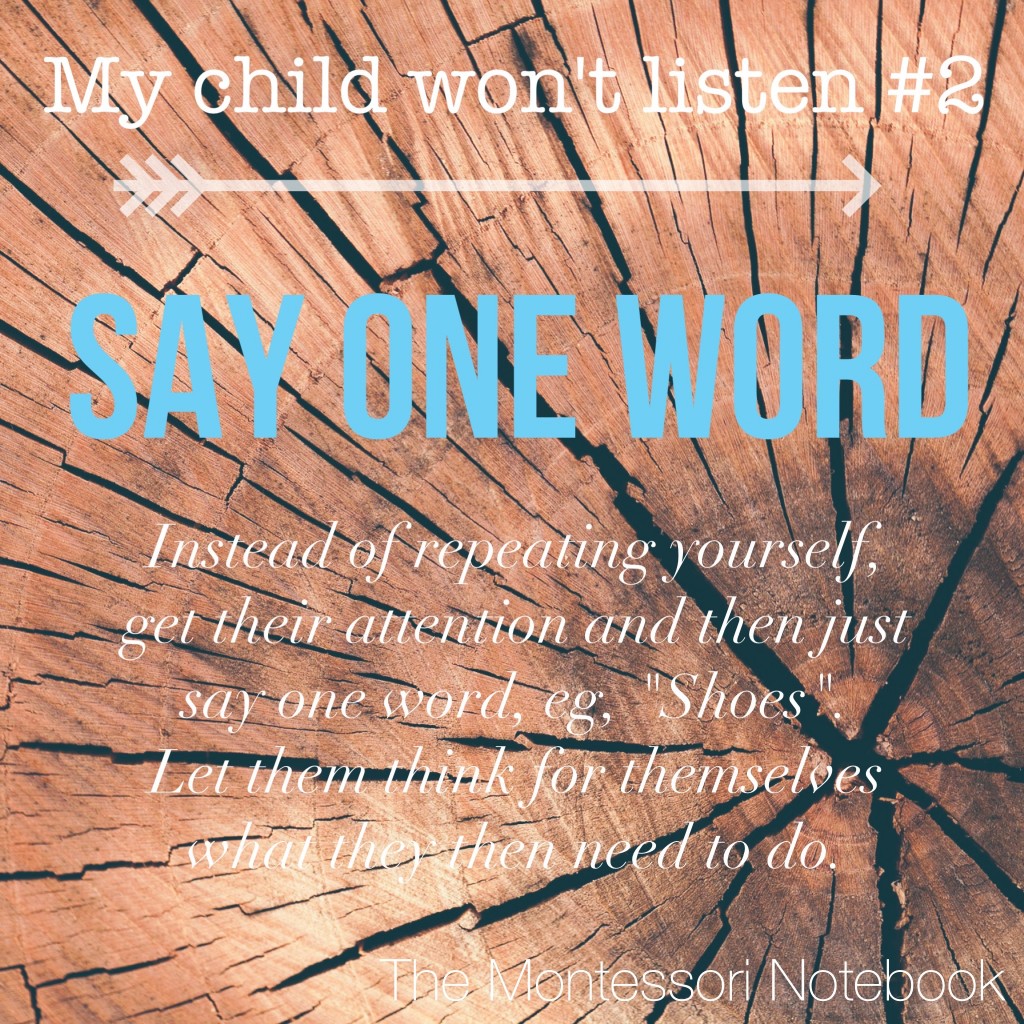
I love this one. Instead of nagging them, we can just use one word and they can work out the rest. Great for kids that don’t like to be told what to do.
It’s also brilliant modelling for your children. My son once said to me, “laces”. I looked down and I was indeed standing on his shoelace which he was trying to tie. A nice way for him to tell me instead of rolling his eyes at me and saying, “Muuuum you’re standing on my shoe lace. How am I supposed to get ready?!”
3. Write a note (even if they don’t read yet)
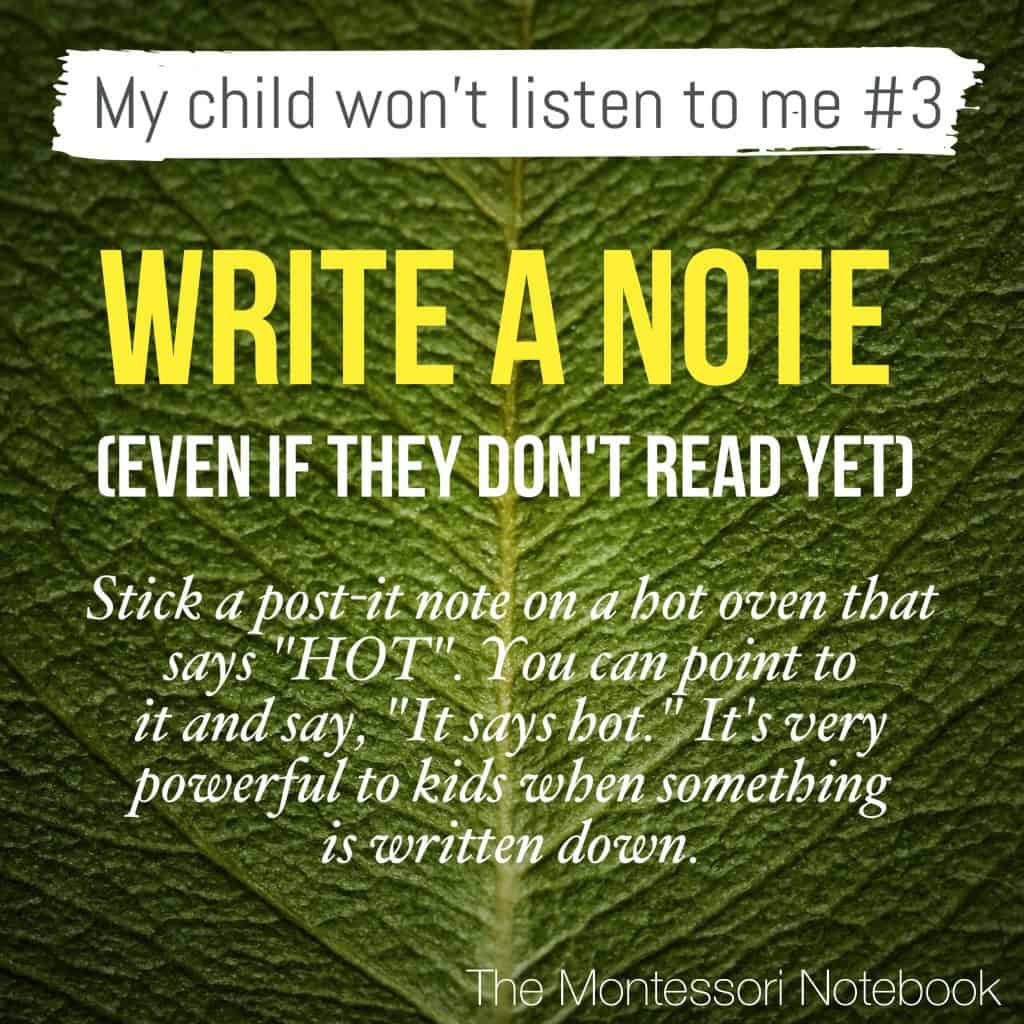
This tip (and #2) are from the book that changed the way I parent, “How to talk so kids will listen and listen so kids will talk” by Faber & Mazlich (click here for a summary of the book). You don’t need to cover your house in notes, but if you have a contentious issue and you find yourself nagging or saying no about it a lot, then try a note.
I’ve seen people put one on the table which says “No climbing”; in a hallway where neighbours complain about kids running, saying “Use tiptoes”; or on a glass cupboard and the note says “Fragile – touch gently.”
I also use this tip to help kids feel heard. If they are having a hard time leaving class, I ask if they’d like me to write a note to remind them for next time. Then I’ll write a note, eg, “playdough” and give it to the to take home. Writing it down that shows I’ve heard and it has been acknowledged. Anyone tried this?
4. Think to yourself, “where does this come from”?
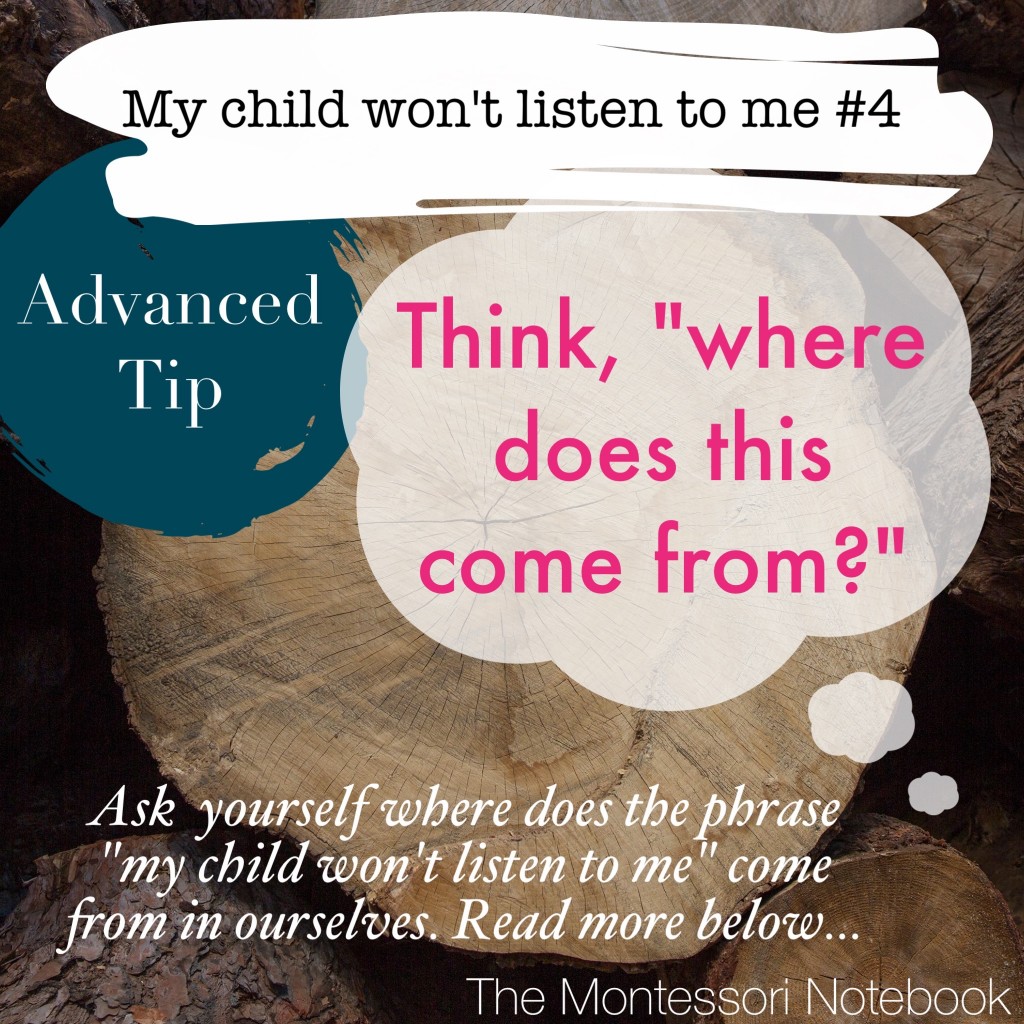
This is a great tip from one of my favourite Montessorians, Pamela Green. Pamela writes,
“Ask the question of where does the phrase, “My child won’t listen……” come from in ourselves. Where does it resonate from within us, and what is our motivation in stating this about our child. Perhaps they are not listening because we are not connected to them, and maybe jump to our own conclusions about what we feel is behind their actions…I find the questions I am sometimes asking of others really are questions or statements that can be used for my own self-reflection.”
Parenting can indeed become a spiritual journey.
5. Allow time to process
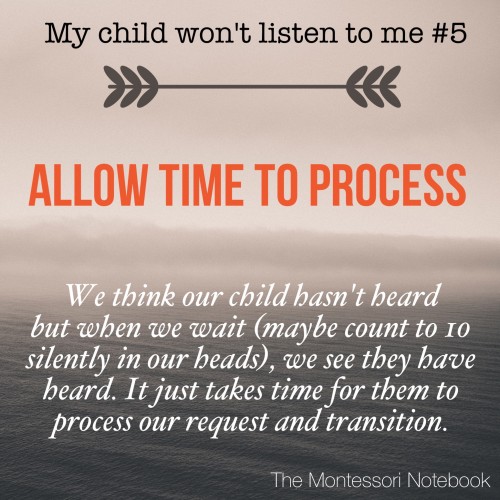
I am always shocked when I stop and count to 10 in my head after making a request from my kids, just how many urges I have to repeat myself in that short period of time. And by the time I get to 8 or 9 in my head I see them starting to respond. No nagging required. It’s brilliant.
Do NOT underestimate the power of allowing some time for them to process what you have said and transition.
6. Be funny
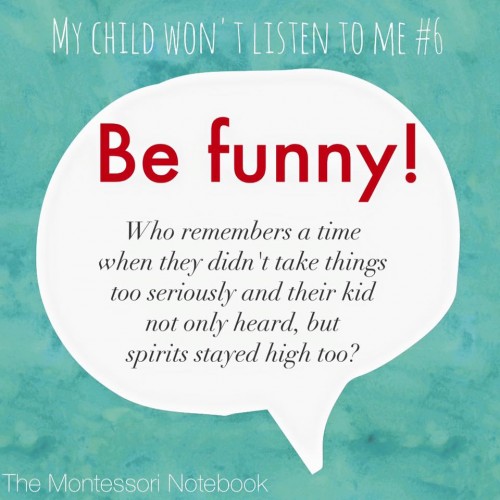
So easy, but so often overlooked. Kids love to be silly. Maybe leaving the house or the park could be lightened by using humour.
My older kids still respond well to me saying “10 minutes bakers!” as they get ready for school – a reference to those cooking shows like Great British Bake Off. Otherwise it’s easy for them to feel rushed and get snappy instead.
7. Get heart to heart
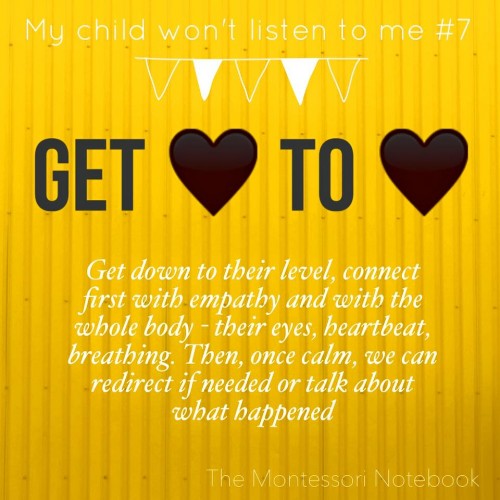
I love this idea from Sveta Pais (and Carrie Schepens) via our Facebook page – first connect, then redirect.
We help them to calm, at their level, with our whole body listening. Then redirect if needed in an age appropriate way and depending on the reason, eg, are they tired, hungry, needing to move etc. Rather than reaching for an iPad or offering a cookie…
8. Break it into steps
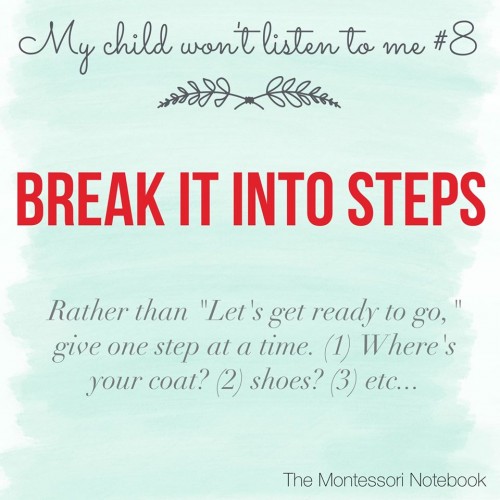
This tip was mentioned in two comments on our Facebook page in this series – by Marian Blevin and Andy Lulka. And it really helps kids “hear” us.
Let’s look at our request and break it into manageable steps. Rather than “let’s tidy the room”, the first step might be, “let’s start with the lego.”
Are you asking too much from your children? Let’s break it into steps.
9. Try ‘working with’ rather than ‘doing to’
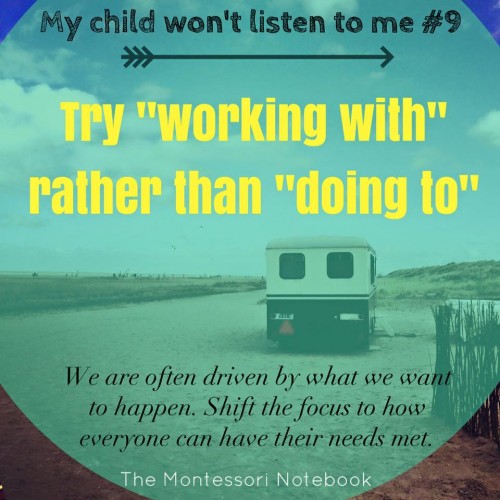
Number 9 is one big SHIFT that’s worth trying. It’s based on the idea of ‘working with’ your children rather than ‘doing to’ from the work of Alfie Kohn. It doesn’t mean the kids are in charge. But what I love about this approach is that everyone can get their needs met.
Imagine an afternoon where the kids want to play and their parent wants to pick up groceries for dinner. We could bribe them (‘doing to’) saying we can go to the park if they are good at the supermarket. Or we can make a subtle shift where everyone gets their needs met by making a plan together (‘working with’).
“I’d like to pick up some things from the shops and you’d like to go to the park. How can we make that work do you think?” They agree to first go to the shops, then go to the park. The same result except in the second case, the child is involved and therefore more likely to cooperate without feeling bribed or manipulated.
This method involves honesty and cooperation in place of surreptitiously making kids do what we want. It doesn’t happen overnight. But your kids will learn that they are also valued members of the family.
10. Can they hear me?
Saving my favourite until last from Andy Lulka…
” “Can they hear me?” Meaning physically, yes, but also emotionally, developmentally and psycho-socially. 🙂 Often, changing our method of instruction, the way we say it, whether we are making eye contact, or tactile contact, the words we use, our sentence structure, can make a big difference. And quite often, what we are asking is not realistic, so even if they can ‘hear’ us, they can’t really hear us. <3"
I asked Andy if she’d like to share any examples. Do any resonate with you?
“- asking a two year old to “stay where I can see you”, moving towards “stay where you can see me”
– asking anyone to do anything in passing and possibly even from another room, moving towards calling their name, waiting for a response that says they’ve heard, and then asking.
– asking a teenager not to do whatever his friends are doing, moving towards be smart even when you’re doing things you know are risky (Jennifer Turney McLaughlin gave me the phrasing “be smart even when you’re being stupid”).
– asking a child with ADHD and auditory processing disorder to stay seated for a large family meal, moving towards asking him to remain in the vicinity of the table
– my son and I came up with a code for when he didn’t want to talk about something or answer my questions.
– when I’ve told my son something, and am getting no response, instead of getting all anxious, I’ve learned to ask “please acknowledge that you’ve heard and understood.” “
Thank you Andy for these words of wisdom.
Hope you’ve enjoyed this series and that you bring these ideas into those challenging days when you feel like your child just won’t listen. You are not alone. We are here supporting you.
PS Here are a few more that people contributed:
- Marian Blevin – Call them over, make eye contact and make sure you have their full attention. Oh and start with one instruction at a time. “Go to the cloakroom, (1),collect your coat(2), shoes,(3) and go to the loo(4). Often adults see this as one instruction… Children see it as a whole string!”
- Joanna Brunet – Bend your knees. Literally. Have your face at the same level as your child, and take 1 minute to explain (what is going to happen, what you expect, why you are requesting something or why you cannot accept his request, etc). “waste” that minute, it saves much more time in the longer run. Works wonders!
- Joanna Brunet – I have another one: Don’t be more demanding with them than you are with yourself. Can you expect a 3years old to master hi nerves, follow the rules, respect others, I you cannot do it?
- Cristi Nelson I think consistency is the biggest mistake i see people make, if you have a rule enforce it all the time in every situation. Otherwise the child has to constantly challenge you to see what the rules actually are! Second i think having too many rules is as bad as having too few!!
(Have a few important rules which are hard limits + be consistent enforcing them with love. The other things you can always say, “let’s see…”) - Pamela Green – Say nothing with words, but listen fully with all of our senses. Sometimes to look and see a child, and to have them feel seen, is enough said.
- Pamela Green – Don’t use the word ‘Don’t’ when asking/requesting something from a child. Rather than saying, ‘Don’t sit on the table’, say, “You may sit on a chair or the floor.” Children hear our words of action, and don’t is not one.